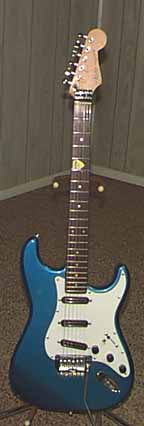You wouldn't think one would feel conspicuous walking the streets of Nashville with a guitar in hand. After all, it is Music City and probably has more pickers per capita than any other city in the U.S.
But there I was, carrying a guitar through the streets of Nashville to a guitar show held there a few weekends ago.
However, it takes a connoisseur to really appreciate a guitar show. After
all, anyone who is not a guitar nut can't understand why grown men are trying
to sell 40-year-old slabs of wood for thousands of dollars - and why some
grown men are buying them.
I went to the show to see interesting guitars and to do a little trading.
Guitar shows also are know for offering some sweet deals on guitars. However,
unless you're looking for a rare guitar, you're better off buying a guitar
from your local music dealer.
Guitars have fascinated me since my teenage years. I think there's a gene
or hormone or something that inspires teenage boys to want to play electric
guitar. Perhaps it's the fantasy that someday you could be playing in front
of thousands of adoring fans, making millions of dollars and have women
going crazy over you.
But very few people ever reach that level of stardom. Like many former guitar
god wannabees, I just hack away in the privacy of my home, mercifully sparing
the rest of the world from hearing my attempts at playing.
This show, held in the Nashville Municipal Auditorium's lower level, wasn't
the largest one I'd been to, but it didn't disappoint me. It brought to
mind some questions about human nature.
For example, just why do old solid-body electric guitars command such princely
prices? There's a belief, propagated by guitar magazines and wealthy rock
stars, that the old guitars are better than the ones made in recent years.
There is something to that theory. A few years ago I witnessed a comparison
of old and new electric guitars of the same make and model. The 1950s vintage
guitars definitely had a special sound.
But the guitars made today represent the best values ever in guitars, and
the difference in sound quality is lost on all but the most discriminating
listeners.
Nonetheless, those old guitars command big bucks. For example, on display
was a 1959 Gibson "Flying V" guitar, so named because it is shaped
like the letter V. These guitars were a commercial flop when first produced.
But in later years, certain rock stars discovered them and played them,
making them valuable.
This particular guitar had a price tag of $49,500. No, that's not a misprint
- you could buy a small house for what you would pay for that guitar. I
wanted to touch the guitar, but I didn't want to risk having to take out
a second mortgage.
The Gibson company couldn't give away its solid body Les Paul model in 1959.
You could pick up one for about $250 back then. If you want one today, figure
on about 100 times that price - $25,000.
Today's newly-manufactured Gibson Les Pauls list for $1,500 and up, but
there are even lower priced models under the Epiphone brand that can be
had for around $600. To the casual eye, there is no difference in the guitar.
But to the discriminating guitar nut, there is a difference.
Many of the 1950s era Fender electric guitars were priced around $3,000
and up at the show. One in particular was a badly worn model that most people
wouldn't look at twice - and the dealer wanted $3,000 for it.
Perhaps one of the strangest developments in guitar building, though, is
"relic" guitars. The Fender guitar company, maker of some of those
vintage instruments, now sells new instruments that look worn out when you
buy them.
Many pickers believe guitars improve with age. The "relic" guitars
have simulated wear and tear to make them feel like an old instrument.
So, in addition to paying a high price for a 40-year-old slab of wood, you
now may pay a high price for a new slab of wood that looks old.
But perhaps "slabs of wood" is not a fair term. There can be magic
in those slabs of wood, whether they're new, old or "relic." Some
guitars just have a certain feel to them. In the hands of an average player,
they are a pleasure to play. In the hands of a great player, those instruments
become magical.
Perhaps we're all in search of a little magic in our lives, and guitars
provide that for some people.
I swapped the relatively new guitar I brought for a 10-year-old instrument.
It will never be worth thousands of dollars. In my amateur hands, it will
never be heard by thousands of people.
But something special happened when I strummed that guitar. It felt good.
It had a little magic in it.
And when I left the building carrying that guitar, I didn't feel quite as
conspicuous walking the streets of Music City.
Home page||Send me an e-mail
||Click here for great deals on CDs!
||Tim Wood's Rocketry page
||Tim Wood's Music Page, featuring Chicago (the band)
 I
went to my first guitar show back in 1984. In the 90s, such shows have become
quite popular.
I
went to my first guitar show back in 1984. In the 90s, such shows have become
quite popular.
Search this site!
